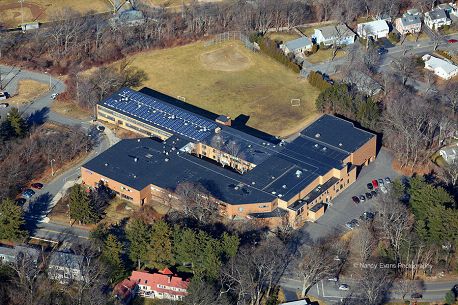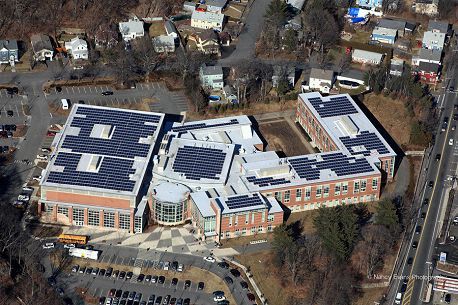Solar Energy

Overview
The Sun provides a solar energy source to create heat and electricity. There are two types of solar technology:
- Passive - Produces heat and provides lighting for fixtures.
- Active - Using solar photovoltaics (PVs) to produce electricity or solar thermal technology to create heat, hot water or electricity.
Solar energy is considered environmentally friendly and a naturally renewable for a number of reasons:
- The sun is a natural energy source;
- It does not require the burning of fossil fuels (or the associated air emissions);
- The energy produced does not deplete any natural resources;
- It will never run out.
As an intermittent energy source, it is not always available such as when it is cloudy, rainy or the evening. When the sun is unavailable, the solar energy systems cannot produce energy. Many systems include a form of energy storage feature or a backup source of energy (such as the electric grid) to make up for this.
Typical forms of solar energy:
- Solar PV - As one of the most common solar technologies used in New England, solar PV is considered one of the most environmentally-friendly technologies available. Easily installed on a building or property, solar panels can be assembled into larger groups (arrays) to produce increasing amounts of electricity.
- Passive Solar - This type of solar uses the sun's energy based on the way a building is oriented, designed, and/or constructed. Buildings designed with passive solar can then meet the remainder of the heating and lighting needs through smaller and cheaper mechanical systems.
- Solar Heating - Solar collectors can be used to provide small-scale water and space heating by concentrating heat in either water pipes or air handling system.
- Solar Thermal Electric - This type of technology can be used on a much larger scale and is similar in concept to solar heating technologies. This technology creates enough heat via sunlight to power a generator that is then used to produce electricity.
(Information provided by the U.S. Environmental Protection Agency)
Projects
Swampscott Solar Challenge:
To help Swampscott receive free solar panels for a town building, the Renewable Energy Committee held a solar challenge for residents. Through the Clean Energy Choice program, the town would be eligible for the free panels if 150 households and businesses signed up to support renewable energy on their electric bills. The Swampscott Solar Challenge was held December 2007 to April 2008.
Swampscott Schools Solar Panels:
The Town of Swampscott, Swampscott School District and Constellation Energy developed a power purchase agreement (PPA) to install solar panels at the middle and high schools. This agreement means that Constellation Energy owns and maintains the solar panels. Because Constellation Energy owns the hardware, the Town did not have to pay for the installation. Swampscott buys the energy produced at a set rate for 20 years - the length of the contract agreement.
- 1,960 total panels installed between the two locations
- 10.6 gigawatt hours are projected to be produced by the solar panels over the course of the 20 years
- Based on average district usage at the time of installation, the panels are projected to provide 19% of the entire school district's electrical needs
- The offset energy produced is equivalent to 1,138 cars being taken off the road
- Live data feed from the panels
- Ribbon-cutting ceremony: April 25, 2012
In the News
- December 29, 2011 - The Daily Item - "Work Nearly Complete on Solar Panel Project for Swampscott Schools"
- April 26, 2012 - Swampscott Patch - "Solar Power Energizes Schools and Enlightens Students"
- April 26, 2012 - The Daily Item - "Swampscott Marks Completion of Solar Power Project"
- April 30, 2012 - Swampscott Reporter - "PHOTO GALLERY: Swampscott School's Solar Project Unveiled"
- February 5, 2013 - Swampscott Patch - "Help Swampscott and Salem Soak Up More Solar Energy"



